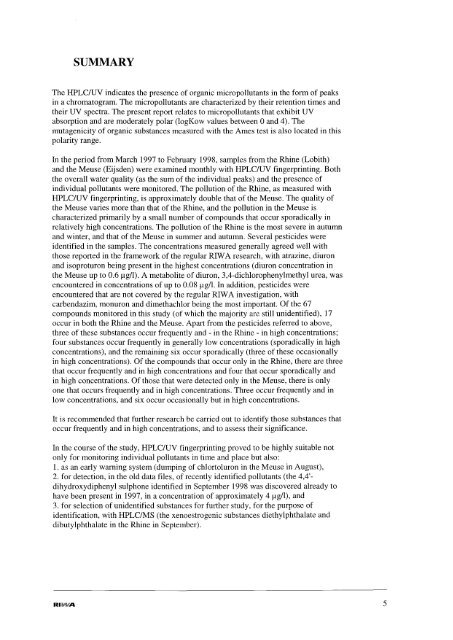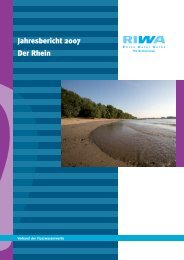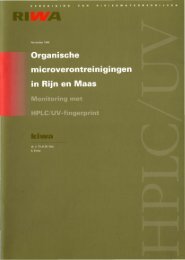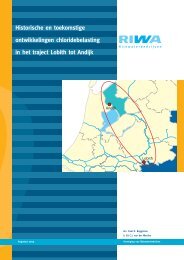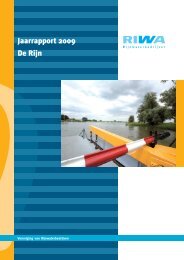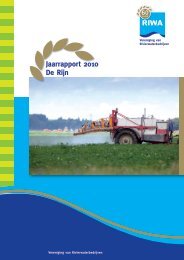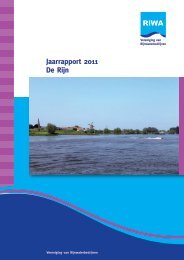Organic micropollutants in Rhine and Meuse a - Riwa
Organic micropollutants in Rhine and Meuse a - Riwa
Organic micropollutants in Rhine and Meuse a - Riwa
Create successful ePaper yourself
Turn your PDF publications into a flip-book with our unique Google optimized e-Paper software.
SUMMARY<br />
The HPLC/UV <strong>in</strong>dicates the presence of organic <strong>micropollutants</strong> <strong>in</strong> the form of peaks<br />
<strong>in</strong> a chromatogram. The <strong>micropollutants</strong> are characterized by their retention times <strong>and</strong><br />
their UV spectra. The present report relates to <strong>micropollutants</strong> that exhibit UV<br />
absorption <strong>and</strong> are moderately polar (logKow values between 0 <strong>and</strong> 4). The<br />
mutagenicity of organic substances measured with the Ames test is also located <strong>in</strong> this<br />
polarity range.<br />
In the period from March 1997 to February 1998, samples from the Rh<strong>in</strong>e (Lobith)<br />
<strong>and</strong> the <strong>Meuse</strong> (Eijsden) were exam<strong>in</strong>ed monthly with HPLC/UV f<strong>in</strong>gerpr<strong>in</strong>t<strong>in</strong>g. Both<br />
the overall water quality (as the sum of the <strong>in</strong>dividual peaks) <strong>and</strong> the presence of<br />
<strong>in</strong>dividual pollutants were monitored. The pollution of the Rh<strong>in</strong>e, as measured with<br />
HPLC/UV f<strong>in</strong>gerpr<strong>in</strong>t<strong>in</strong>g, is approximately double that of the <strong>Meuse</strong>. The quality of<br />
the <strong>Meuse</strong> varies more than that of the Rh<strong>in</strong>e, <strong>and</strong> the pollution <strong>in</strong> the <strong>Meuse</strong> is<br />
characterized primarily by a small number of compounds that occur sporadically <strong>in</strong><br />
relatively high concentrations. The pollution of the Rh<strong>in</strong>e is the most severe <strong>in</strong> autumn<br />
<strong>and</strong> w<strong>in</strong>ter, <strong>and</strong> that of the <strong>Meuse</strong> <strong>in</strong> summer <strong>and</strong> autumn. Several pesticides were<br />
identified <strong>in</strong> the samples. The concentrations measured generally agreed well with<br />
those reported <strong>in</strong> the framework of the regular RIWA research, with atraz<strong>in</strong>e, diuron<br />
<strong>and</strong> isoproturon be<strong>in</strong>g present <strong>in</strong> the highest concentrations (diuron concentration <strong>in</strong><br />
the <strong>Meuse</strong> up to 0.6 I-lg/l). A metabolite of diuron, 3,4-dichlorophenylmethyl urea, was<br />
encountered <strong>in</strong> concentrations of up to 0.08 I-lg/l. In addition, pesticides were<br />
encountered that are not covered by the regular RIWA <strong>in</strong>vestigation, with<br />
carbendazim, monuron <strong>and</strong> dimethachlor be<strong>in</strong>g the most important. Of the 67<br />
compounds monitored <strong>in</strong> this study (of which the majority are still unidentified), ]7<br />
occur <strong>in</strong> both the Rh<strong>in</strong>e <strong>and</strong> the <strong>Meuse</strong>. Apart from the pesticides referred to above,<br />
three of these substances occur frequently <strong>and</strong> - <strong>in</strong> the Rh<strong>in</strong>e - <strong>in</strong> high concentrations;<br />
four substances occur frequently <strong>in</strong> generally low concentrations (sporadically <strong>in</strong> high<br />
concentrations), <strong>and</strong> the rema<strong>in</strong><strong>in</strong>g six occur sporadically (three of these occasionally<br />
<strong>in</strong> high concentrations). Of the compounds that occur only <strong>in</strong> the Rh<strong>in</strong>e, there are three<br />
that occur frequently <strong>and</strong> <strong>in</strong> high concentrations <strong>and</strong> four that occur sporadically <strong>and</strong><br />
<strong>in</strong> high concentrations. Of those that were detected only <strong>in</strong> the <strong>Meuse</strong>, there is only<br />
one that occurs frequently <strong>and</strong> <strong>in</strong> high concentrations. Three occur frequently <strong>and</strong> <strong>in</strong><br />
low concentrations, <strong>and</strong> six occur occasionally but <strong>in</strong> high concentrations.<br />
It is recommended that further research be carried out to identify those substances that<br />
occur frequently <strong>and</strong> <strong>in</strong> high concentrations, <strong>and</strong> to assess their significance.<br />
In the course ofthe study, HPLC/UV f<strong>in</strong>gerpr<strong>in</strong>t<strong>in</strong>g proved to be highly suitable not<br />
only for monitor<strong>in</strong>g <strong>in</strong>dividual pollutants <strong>in</strong> time <strong>and</strong> place but also:<br />
1. as an early warn<strong>in</strong>g system (dump<strong>in</strong>g of chlortoluron <strong>in</strong> the <strong>Meuse</strong> <strong>in</strong> August),<br />
2. for detection, <strong>in</strong> the old data files, of recently identified pollutants (the 4,4'<br />
dihydroxydiphenyl sulphone identified <strong>in</strong> September 1998 was discovered already to<br />
have been present <strong>in</strong> 1997, <strong>in</strong> a concentration of approximately 4 I-lg/l), <strong>and</strong><br />
3. for selection of unidentified substances for further study, for the purpose of<br />
identification, with HPLC/MS (the xenoestrogenic substances diethylphthalate <strong>and</strong><br />
dibutylphthalate <strong>in</strong> the Rh<strong>in</strong>e <strong>in</strong> September).<br />
RlllI'VA 5


